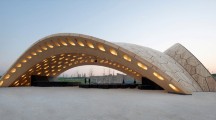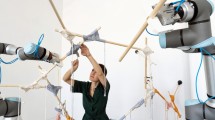Abstract
Wood is more and more seen as a sustainable solution to offset carbon emissions from constructions. In response and in parallel to this, the research in robotic timber construction is evolving rapidly, pushed by Industry 4.0 technologies and the integration of digital and physical robotic assets. This paper presents an approach for the design and assembly automation of layered timber structures, with the use of a flexible cell based on collaborative robots. Advanced assembly procedures and digital design of non-standard timber structures are here established and integrated. The automation process is here enhanced by the (1) use of feedback systems based on the location and force signals, (2) the introduction of a flexible robot setup with automatic screwing, and (3) human-collaboration to provide immediate assistance to the robot in the case the signals do not match the defined assembly conditions. The paper discusses the development and use of a Cyber-Physical System to govern the entire construction process, including reflections on the integrated approach to the design, modelling and simulation of the process.












Similar content being viewed by others
References
Adel A, Thoma A, Helmreich M, Gramazio F, Kohler M (2018) Design of robotically fabricated timber frame structures. In: Paper proceedings of the 38th annual conference of the association for computer aided design in architecture, Acadia Publishing Company, Mexico, 2018, pp 394–403. ISBN 978-0-692-17729-7
Apolinska AA (2018) Complex timber structures from simple elements. Computational design of novel bar structures for robotic fabrication and assembly. PhD Dissertation, ETH Zurich https://doi.org/10.3929/ethz-b-000266723
Apolinska AA, Knauss M, Gramazio F, Kohler M (2016) Sequential roof. In: Menges A et al (eds) Advancing wood architecture: a computational approach. Routledge, London, New York, pp 45–57
Arup (2019) Rethinking timber buildings. Seven perspectives on the use of timber in building design and construction, Report. Arup, London. https://www.arup.com/perspectives/publications/research/section/rethinking-timber-buildings. Accessed June 2020
Bartodziej CJ (2017) The concept industry 4.0. An empirical analysis of technologies and applications in production logistics. Springer-Gabler, Wiesbaden, Germany
Bianconi F, Filippucci M (2019) Digital wood design. Innovative techniques of representation in architectural design, Springer Nature Switzerland AG
Brecher C (2017) Integrative production technology: theory and applications. Springer, Berlin, Germany
Cailhol S, Fillatreau P, Zhao Y, Fourquet J-Y (2019) Multi-layer path planning control for the simulation of manipulation tasks: Involving semantics and topology. Robot Comput-Integrat Manufact 57:17–28
Colella M, Fallacara G (2019) Towards a 4.0 mass customized wooden housing in the mediterranean area: the ecodomus project. In: Bianconi, F., Filippucci, M. (eds.) Digital wood design, innovative techniques of representation in architectural design 1201–1228. Springer Nature Switzerland AG
Eversmann P, Gramazio F, Kohler M (2017) Robotic prefabrication of timber structures: towards automated large-scale spatial assembly. Construct Robot 1(1–4):49–60
Helm, V, Knauss, M, Kohlhammer T, Gramazio F, Kohler M (2016) Additive robotic fabrication of complex timber structures. In: Menges, A. et al. (eds.) Advancing wood architecture: a computational approach 29–43. Routledge
Hietanen A, Latokartano J, Foia A, Pieters R, Kyrki V, Lanz M, Kamäräinen J-K (2020) Object pose estimation in robotics revisited. arXiv:1906.02783. Accessed April 2020
Krammer M (2016) Individual serialism through the use of robotics in the production of large-scale building components. ROBARCH. https://doi.org/10.1007/978-3-319-26378-6_38
Lee Y, Hu ES, Yang Z, Yin A, Lim JJ (2019) IKEA furniture assembly environment for long-horizon complex manipulation tasks. arXiv:1911.07246. Accessed May 2020
Malakooti B (2013) Operations and production systems with multiple objectives. John Wiley and Sons, Hoboken, NJ, USA
Menges A, Schwinn T, Krieg OD (2016) Advancing wood architecture: a computational approach. Routledge, London, New York
Morshedzadeha I, Oscarssona J, Nga A, Aslama T, Frantzén M (2018) Multi-level management of discrete event simulation models in a product lifecycle management framework. Proced Manufact 25:74–81
MuJoCo–Homepage (2020) http://www.mujoco.org/index.html. Accessed April 2020
Nguyen H, Pham Q-C (2019) A probabilistic framework for tracking uncertainties in robotic manipulation. arXiv:1901.00969. Accessed April 2020
Naboni R, Kunic A (2019) A computational framework for the design and robotic manufacturing of complex wood structures. In: Sousa JP, et al. (eds.) Architecture in the age of the 4th industrial revolution: proceedings of the 37th eCAADe and 23rd SIGraDi Conference, Porto 189–196
Open Dynamics Engine–Homepage (2020) http://ode.org/. Accessed May 2020
Schlette C, Book AG, Aksoy EE, Steil T, Savarimuthu TR, Krüger N, Wörgötter F, Roßmann J (2014) A new benchmark for pose estimation with ground truth from virtual reality. Produc Eng Res Develop 8(6):745–754
Schlette C, Buch AG, Hagelskjær F, Iturrate I, Kraft D, Kramberger A, et al. (2019) towards robot cell matrices for agile production–SDU Robotics' assembly cell at the WRC 2018. Advanced robotics, special issue on industrial robot technology: selected papers from WRS 2018 34 422–438
Schwartz T (2012) HAL: extension of a visual programming language to support teaching and research on robotics applied to construction. ROBARCH. https://doi.org/10.1007/978-3-7091-1465-0_8
Sloth C, Kramberger A, Iturrate I (2020) Towards easy setup of robotic assembly tasks. Advanced Robotics 34:7–8
Studio RAP: circular experience (2017). Retrieved from https://studiorap.nl/#/abnamro, Accessed in May 2020
Stumm S, Brell-Çokcan S (2018) Haptic programming. ROBARCH. https://doi.org/10.1007/978-3-319-92294-2_4
Stumm S, Devadass P, Brell-Cokcan S (2018) Haptic programming in construction. Construct Robot Special Issue Adv Architect Robot 2(1–4):3–13
Søndergaard A, Amir O, Eversmann P, Piskorec L, Stan F, Gramazio F, Kohler M (2016) Topology optimization and robotic fabrication of advanced timber space-frame structures. ROBARCH. https://doi.org/10.1007/978-3-319-26378-6_14
Thoma A, Adel A, Helmreich M, Wehrle T, Gramazio F, Kohler M (2018) Robotic fabrication of bespoke timber frame modules. ROBARCH. https://doi.org/10.1007/978-3-319-92294-2_34
Universal robots: real-time data exchange (RTDE) guide. Retrieved from https://www.universal-robots.com/articles/ur-articles/real-time-data-exchange-rtde-guide/, Accessed in May 2020
Willmann J, Gramazio F, Kohler M (2016) New paradigms of the automatic. Robotic timber construction in architecture. In: Menges A. et al. (eds.) Advancing wood architecture: a computational approach 13–27. Routledge
Acknowledgements
This research has been developed as an interdisciplinary collaboration between the CREATE Group and SDU Robotics, both from the University of Southern Denmark. The work was developed with the support of SDU Industry 4.0 Lab, and the Section for Civil and Architectural Engineering. The authors also wish to thank Luca Breseghello and Takwa ElGammal for their contribution to the research development and fabrication.
Author information
Authors and Affiliations
Corresponding author
Ethics declarations
Conflict of interest
On behalf of all authors, the corresponding author states that there is no conflict of interest.
Additional information
Publisher's Note
Springer Nature remains neutral with regard to jurisdictional claims in published maps and institutional affiliations.
Rights and permissions
About this article
Cite this article
Naboni, R., Kunic, A., Kramberger, A. et al. Design, simulation and robotic assembly of reversible timber structures. Constr Robot 5, 13–22 (2021). https://doi.org/10.1007/s41693-020-00052-7
Received:
Accepted:
Published:
Issue Date:
DOI: https://doi.org/10.1007/s41693-020-00052-7




